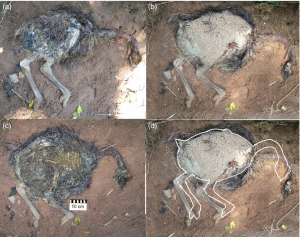
Powerful head and neck retractions of vertebrate carcasses, including dinosaur fossils, have puzzled researchers as to whether they occurred just before an animal’s death in agony, or after. Now experiments performed in the wild on large ostrich chick cadavers show that they occur post-mortem.
The experiments show that the timing of soft tissue decay is critical, and that muscle destruction or loss of tone must occur before ligament destruction. This would allow for the release of stored energy in the ligament and result in vertebral retraction.
The wider implications of the study concerns one of the most controversial dinosaurs known, Sinosauropteryx , which is thought by some to have been feathered and to have died in water.
“While emphasis on Sinosauropteryx has been on its alleged and highly questionable protofeathers, the present study offers considerably more constructive research on how the dinosaur died,” said Prof. Theagarten Lingham-Soliar, author of the Journal of Zoology study.
Reference:
T. Lingham-Soliar. Experiments on ostrich decomposition and opisthotonus with implications for theropod dinosaurs. Journal of Zoology, 2016; DOI: 10.1111/jzo.12345
Note: The above post is reprinted from materials provided by Wiley.










